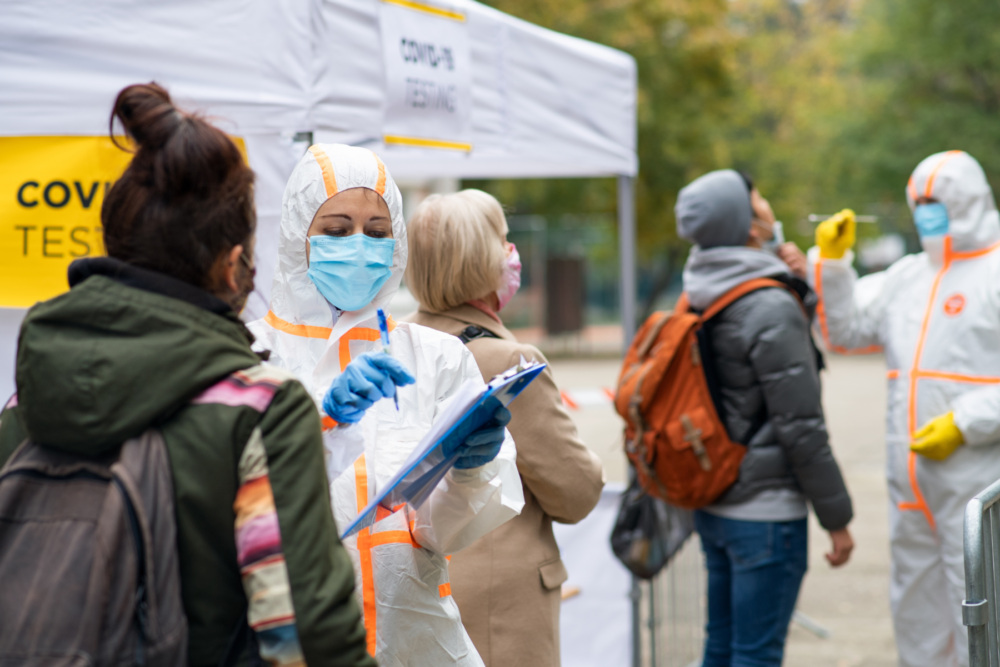
NTI | bio experts address G7 Global Partnership Working Group in Berlin
NTI experts briefed government representatives at a G7 working group meeting in Berlin.
The vast majority of countries that entered the COVID-19 pandemic with strong capacity to prevent, detect, and respond to disease threats achieved lower pandemic mortality rates than less prepared nations, according to a major new study published today in BMJ Global Health. The analysis was led by researchers from the Brown University School of Public Health, the Bill & Melinda Gates Foundation, and the Nuclear Threat Initiative (NTI).
The study found that when accounting for two key differences between countries—the age of their populations and their capacity to diagnose COVID-19 cases and deaths—the pandemic clearly was less deadly in countries that rank high on the Global Health Security Index, which measures the pandemic preparedness capacities of 195 countries.
The researchers sought to understand how different countries performed during the COVID-19 pandemic and how that relates to their pandemic preparedness capacity as measured by the GHS Index.
To answer this question, they assessed countries’ pandemic performance by examining “comparative mortality ratios,” which involved adjusting countries’ “excess deaths” to account for differences in the age of each country’s population. Excess deaths are calculated by comparing the number of deaths that occurred during the pandemic to pre-pandemic death trends. When the researchers took this approach, they found a significant correlation between higher levels of pandemic preparedness capacity and lower excess COVID-19 mortality. Overall, these findings correct earlier observations that countries that scored high on preparedness, including in the GHS Index, paradoxically experienced the worst overall COVID outcomes and the highest COVID-19 death rates.
“Our analysis confirms what you would expect, which is that preparing for pandemics before they occur means we can save more lives during a global health emergency,” said Dr. Jennifer Nuzzo, Director of the Pandemic Center at the Brown University School of Public Health and the senior author of the study. “Countries that took significant action before the pandemic to invest in capacity to prevent, detect and respond to these types of events were much more effective at protecting the health of their populations and had much better outcomes overall.”
The study is the first comprehensive analysis of the “comparative mortality ratio” that accounts for a key factor that can distort national death rates: the age-related demographics of the population. Accounting for age is important when measuring pandemic response performance because countries with older populations tend to have higher baseline mortality rates. The use of the “comparative mortality ratio” also accounts for the fact that some countries with weak disease detection and reporting systems tend to under-report COVID cases and deaths—which can distort the data and make it look like better prepared countries did worse than those with fewer capacities. The authors note that the failure to account for age and reporting capabilities has led some to the erroneous conclusion that strong pandemic preparedness capacity has had little impact on COVID outcomes.
“It is crucial to get the details right when analyzing the relationship between pandemic preparedness capacity and outcomes,” said Dr. Jaime M. Yassif, Vice President of Global Biological Policy and Programs at NTI. “As countries evaluate their COVID-19 performance, we can now point to clear evidence of the immense value of building essential pandemic preparedness capacity and the deadly consequences of failing to do so.”
Although most highly prepared countries appear to have used their capacities well, the United States emerged as a key outlier. Despite ranking highest in the Index, 62 countries had lower comparative mortality ratios than the United States, illustrating that the way a country uses the tools and resources at its disposal also impact its overall performance.
The study highlights one factor that could help explain the United States’ performance. It entered the pandemic with relatively poor scores in what the GHS Index calls the “risk environment,” which includes measures of a country’s capacity to develop and implement policies that can affect its ability to marshal a timely, effective response. The study explains that in the United States, these deficiencies were manifest in a disorganized COVID-19 response that was likely hampered by different control measures in different states, rules that slowed down the distribution of testing equipment, and inconsistent messaging that may have undermined compliance with pandemic control measures like social distancing and vaccination.
Separately, the study found that top performers in the GHS Index risk environment category—including Iceland, Australia and New Zealand—also posted some of the lowest mortality rates during the pandemic.
“This study offers compelling evidence that lack of preparedness tragically led to greater loss of life during the COVID-19 pandemic, and these vulnerabilities will continue to hold populations at risk when new infectious disease threats inevitably emerge in the future,” said Dr. Oyewale Tomori, a virologist and former president of the Nigerian Academy of Science who is closely involved in a number of global initiatives to improve pandemic response. “This evidence, borne from the GHS Index, highlights the importance of getting every country—especially low-income ones—to have complete, properly analyzed information to drive efficient and effective pandemic response. This underscores the value of ongoing GHS Index assessments.”
###
Media contact: Cathy Gwin, 202-270-5942, [email protected]
Sign up for our newsletter to get the latest on nuclear and biological threats.
NTI experts briefed government representatives at a G7 working group meeting in Berlin.
The World Bank launches a new fund to support pandemic prevention, preparedness, and response.
NTI joined governments and organizations from around the world for the 2nd Global COVID-19 Summit on May 12, 2022 and committed to provide $35,000 to the pandemic preparedness and global health security financial intermediary fund.


